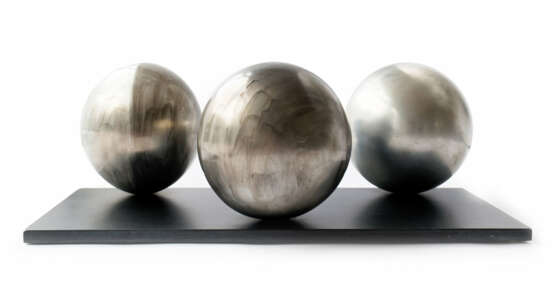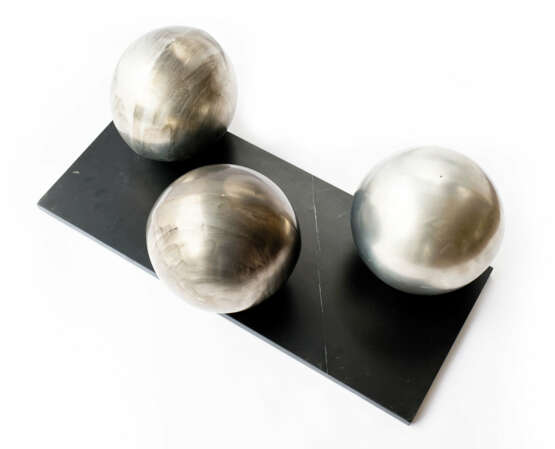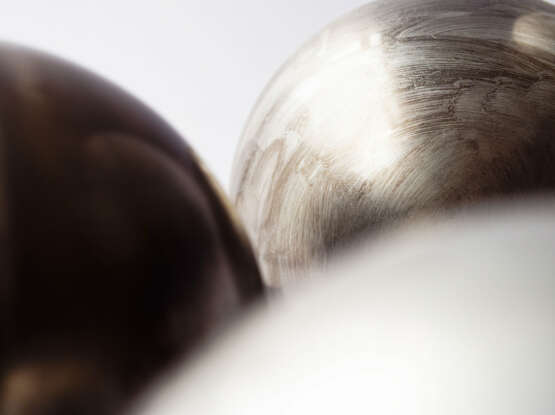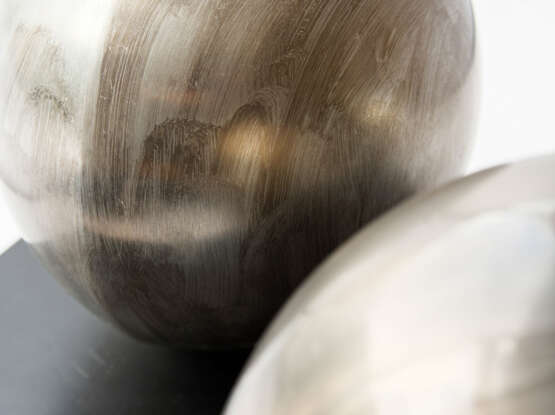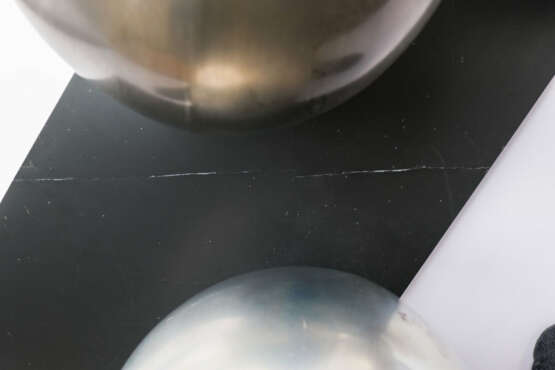ID 655622
Lot 83 | '3 eingezogene Kugeln'
Estimate value
€ 14 000
'3 eingezogene Kugeln', 1969, Metall, kadmiert, auf Steinplatte, Maße 28,2 cm x 75 cm x 44,7 cm, Steinplatte leicht bestoßen, Kaufbeleg anbei, Provenienz: Galerie Thilo Liemersdorf, Essen 1972, Privatsammlung Essen, Ausstellungen: 30.11.1983 - 8.1.1984, "Ernst Hermanns - Arbeiten 1960 bis 1983", Städtische Galerie im Lenbachhaus, München, Literatur: Wvz. 153, Fehler im Werkverzeichnis, Katalog "Ernst Hermanns", Städtisches Museum Leverkusen, Schloss Morsbroich unter Werkverzeichnis letzte Seite; Katalog "Ernst Hermanns" Plastiken 1960-1983, S. 48 & 75; "Wenn mehrere Einzelformen in Bezug zueinander treten, entsteht eine Raumspannung von Körper zu Körper. Der Raum wird als verbindender Teil der Plastik einbezogen und erhält eine neue Bedeutung." (Ernst Hermanns, zit. n.: Das Kunstwerk. Zeitschrift für moderne Kunst 15 (1961/62), S. 25.) Die drei Edelstahlkugeln, von denen zwei als zusammengefügte Kalotten erkennbar sind, sind auf einer Schieferplatte festmontiert und damit in eine Raum-Form-Korrelation gesetzt. Ihre polierte Oberfläche ist mit Pinselstrukturen gewischt. Die transportable Raumplastik repräsentiert das Anliegen des Plastikers Ernst Hermanns, der nicht nur für die zeitgenössische Kunst in Nordrhein-Westfalen von herausragender Bedeutung ist, sondern längst als Raum- und Installationskünstler internationalen Rang besitzt, in vollkommener Weise. 2014 zeigte das Museum DKM in Duisburg, das eine große Hermanns-Sammlung besitzt und es sich zur Aufgabe gemacht hat, das Werk des Künstlers umfassend zu präsentieren, eine große Werkschau und setzte es in Beziehung zu vergleichbaren Positionen der internationalen Plastik wie Norbert Kricke, Günter Fruhtrunk und Donald Judd. Hermanns arbeitete mit Metallobjekten in Form von asymmetrischen Kuben, Kugeln und Stelen aus poliertem, aber nicht glänzendem Edelstahl im Raum. Die "Räumlichen Konstellationen", wie er sie nannte, existieren als Rauminstallationen und als transportable Kunstobjekte, funktionieren also im großen und im kleinen Maßstab. Sein zentrales Anliegen kreiste um die Idee, den Zwischenraum zwischen mehreren korrespondierenden Objekten als konstitutiven Teil des Kunstwerks zu thematisieren. Nach seiner Auffassung sind Form und Raum gleichwertig, der Raum wird zum notwendigen Teil der Plastik. Hatte er in den 1950er Jahren noch mit vielgestaltigen, durchbrochenen Formen mit aufgerissenen strukturierten Oberflächen gearbeitet, vereinfachte sich das Vokabular ab 1960 stetig, um schließlich bei jenem begrenzten Repertoire an geschlossenen Formen aus Rund- und Vierkantstäben, runden und rechteckigen Scheiben und immer wieder Kugeln zu landen, die seine Arbeiten von da an auszeichneten. Hermanns studierte an der Kunstgewerbeschule in Aachen und an der Kunstakademie Düsseldorf. Nach dem Krieg gründete er 1948 in Recklinghausen mit weiteren Künstlern, darunter Emil Schumacher und Heinrich Siepmann, die Gruppe "junger Westen". Arbeiten befinden sich im Museum Folkwang Essen, der Städtischen Galerie im Lenbachhaus München, im Museum Am Abteiberg Mönchengladbach und anderen Sammlungen. Den größten Werkbestand besitzt das Museum DKM in Duisburg, wo zugleich der künstlerische Nachlass betreut wird.
| Auction house category: | Modern and contemporary sculptures |
|---|
| Auction house category: | Modern and contemporary sculptures |
|---|
| Address of auction |
WETTMANN | Auktionshaus an der Ruhr Friedrichstraße 67-67a 45468 Mülheim an der Ruhr Germany | ||||||||||||||
|---|---|---|---|---|---|---|---|---|---|---|---|---|---|---|---|
| Preview |
| ||||||||||||||
| Phone | +49 (0)208 3059081 | ||||||||||||||
| Fax | +49 (0)208 4391735 | ||||||||||||||
| Buyer Premium | 30% | ||||||||||||||
| Conditions of purchase | Conditions of purchase | ||||||||||||||
| Business hours | Business hours
|
